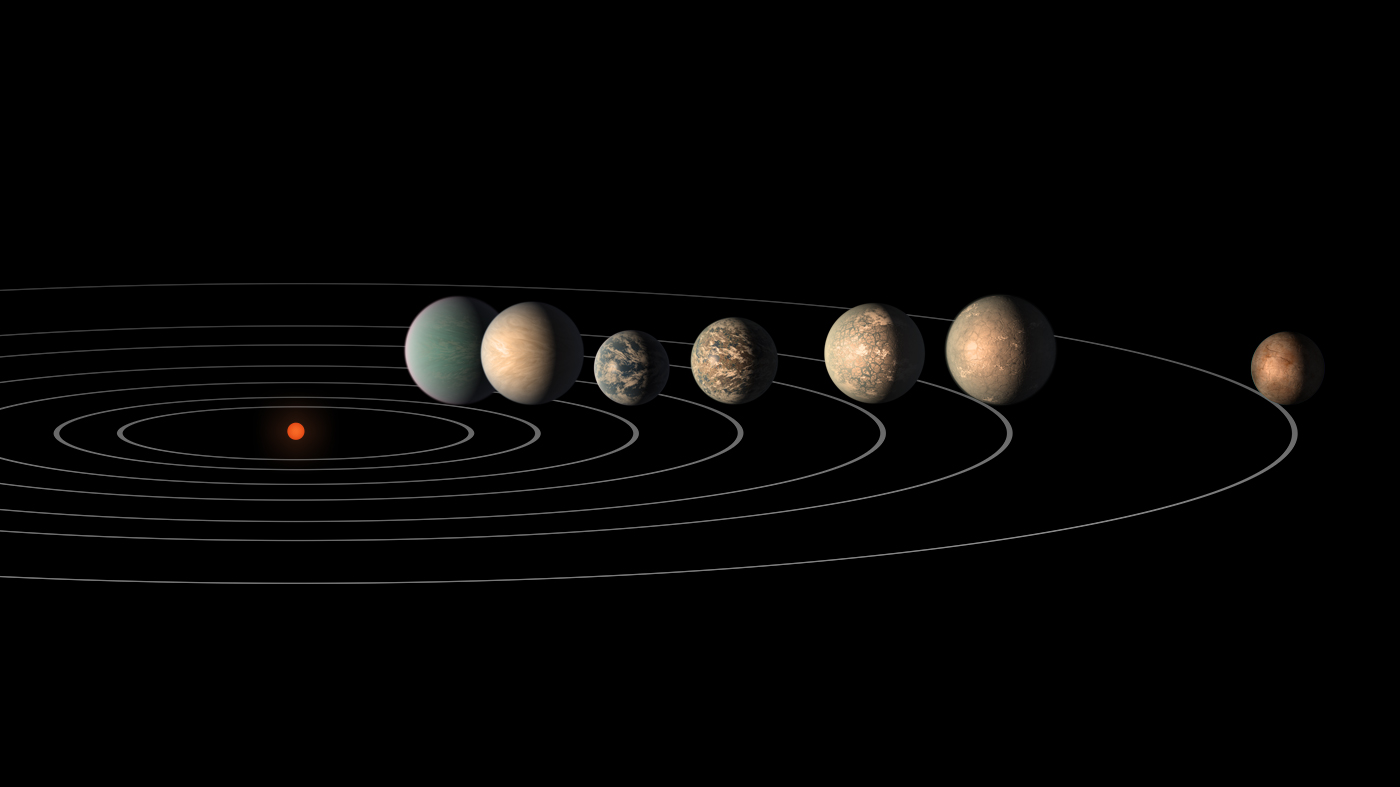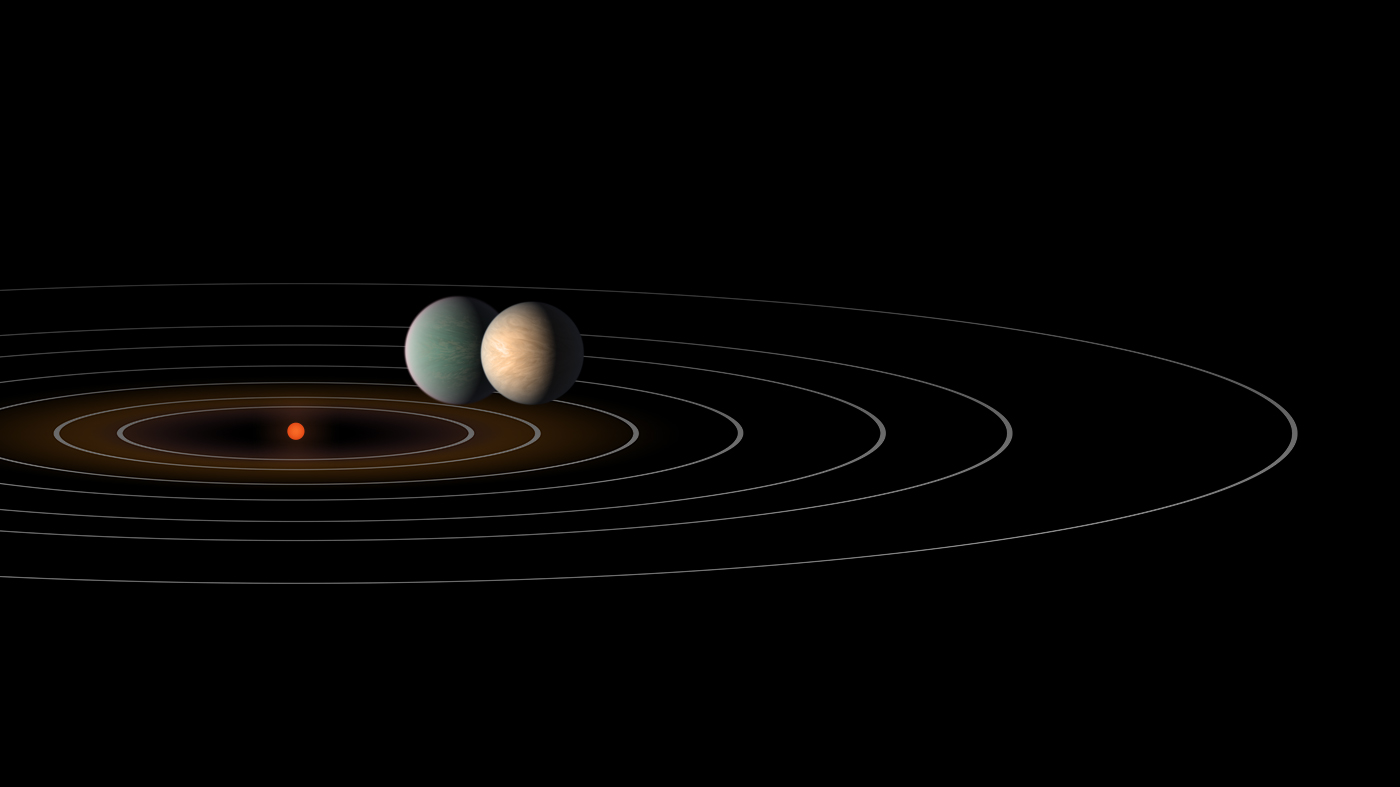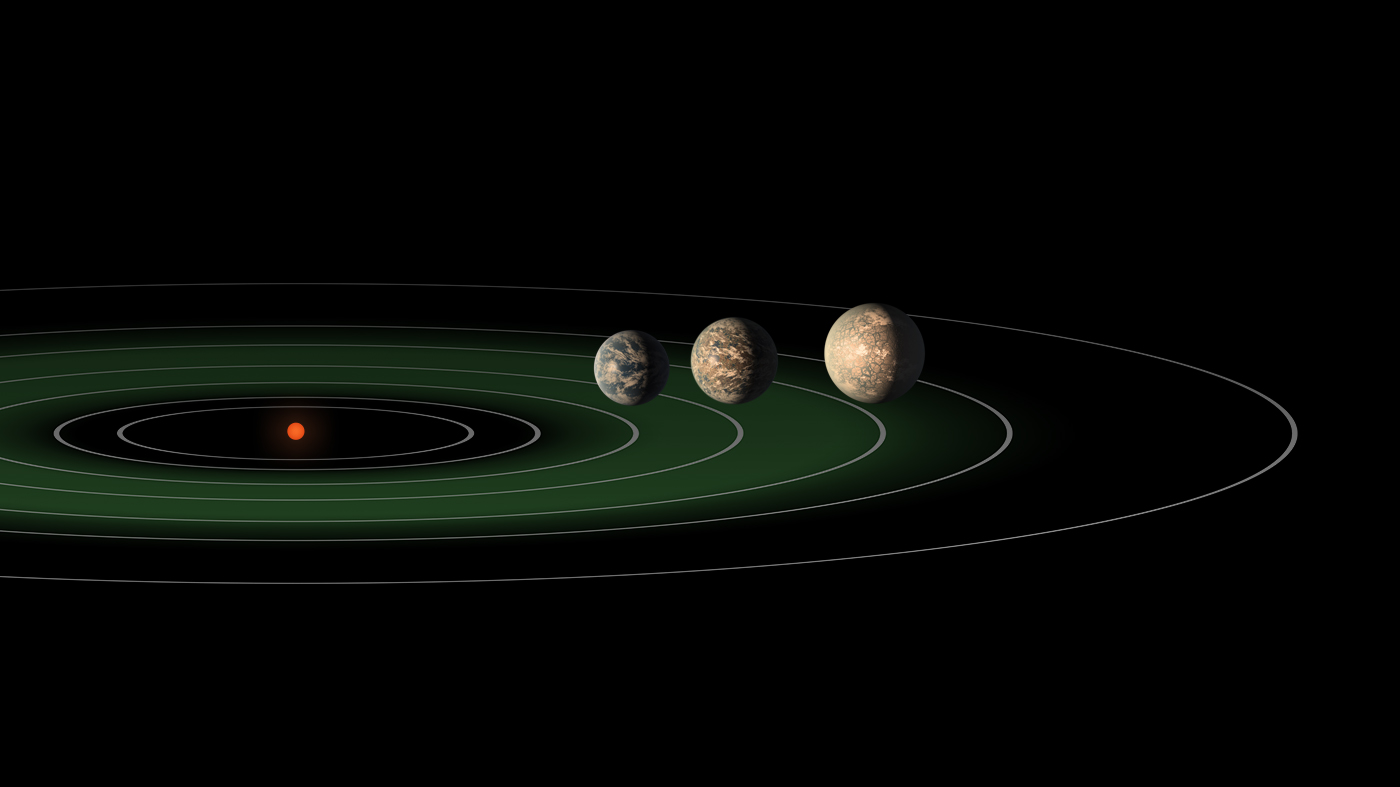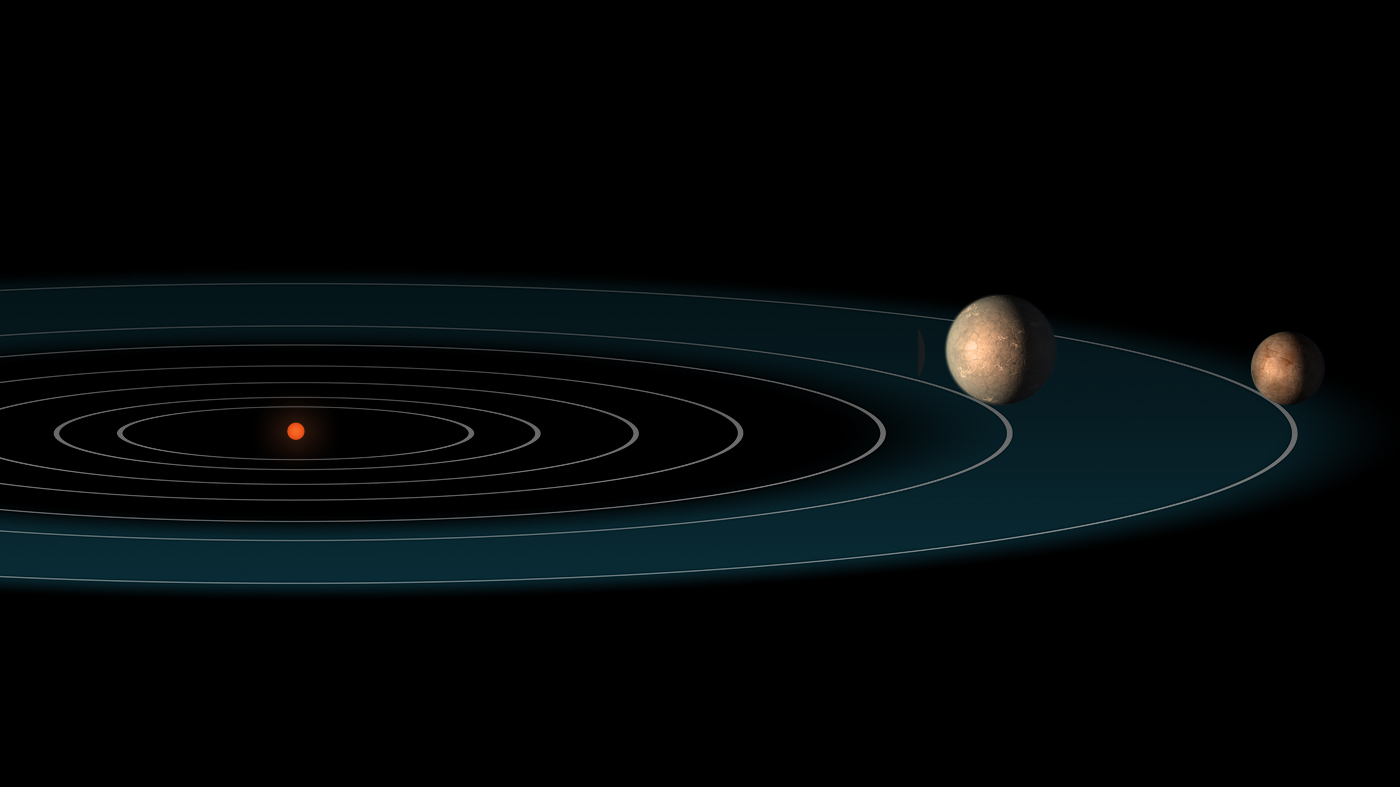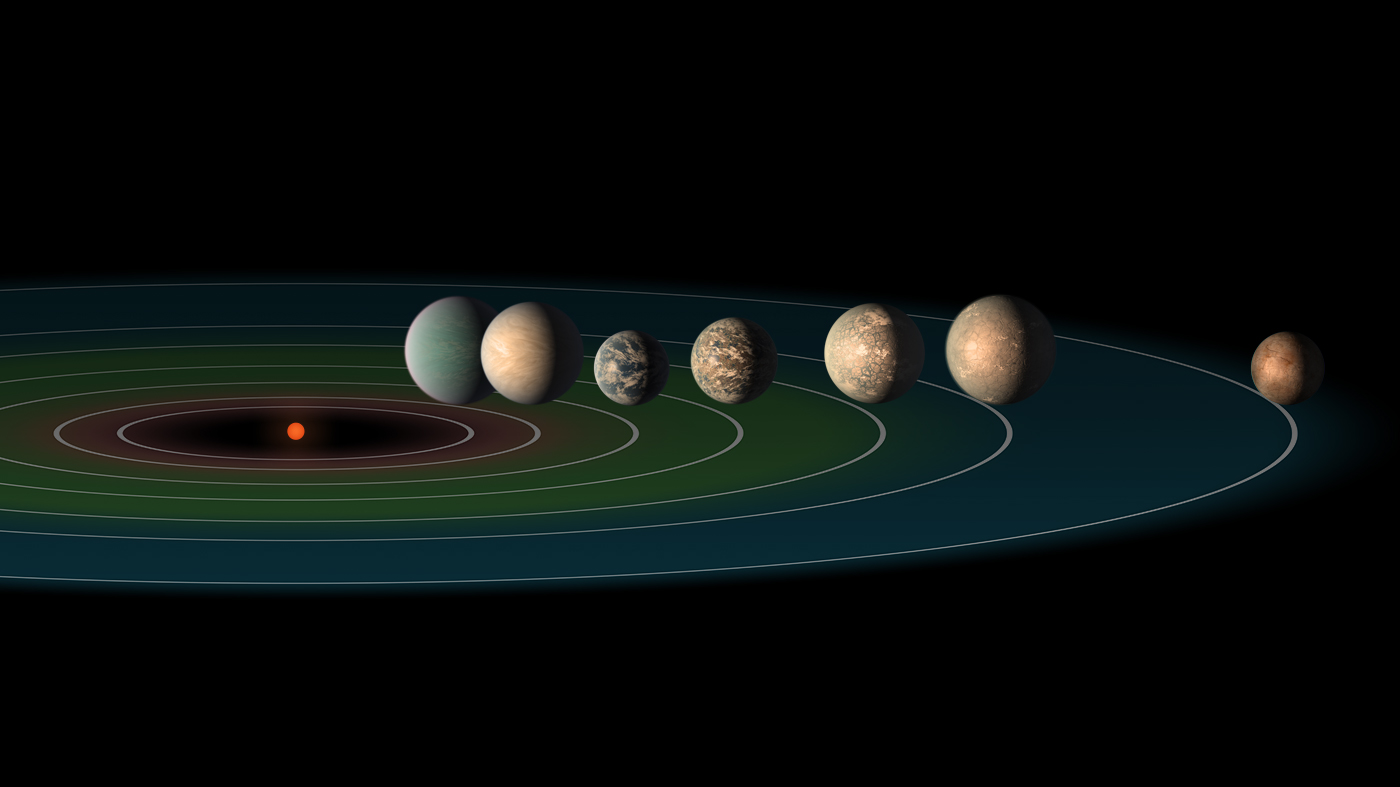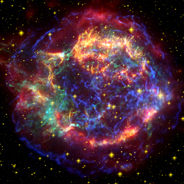Interactive Overview
Slider Interactive: A series of artist concepts (illustrations) highlighting the different types of orbits that exist among the seven planets of the TRAPPIST-1 exoplanet system. Below the caption is a horizontal slider bar with five labeled stops and a solid white circle. Dragging the white circle right and left along the slider bar causes the illustration, labels, and caption to change. The change occurs gradually as one illustration, along with its associated captions and labels, fades out and the next fades in. A toggle button to the upper right of the illustration turns the image labels off and on. Labels are in the form of text with arrows pointing to specific features in the illustration.
Slider Stops
From left to right, the slider stops are labeled: TRAPPIST-1 System, Inner Orbits, Goldilocks Zone, Outer Orbits, and All Orbits.
Summary of Slider Stops
Sliding left to right reveals the following:
- “TRAPPIST-1 System” stop shows an oblique view of seven Earth-sized planets orbiting their star, highlighting the differences in planet size and distance from the star. This is the initial image shown when the interactive is loaded.
- “Inner Orbits” stop shows the two exoplanets closest to the system’s star.
- “Goldilocks Zone” stop shows the three middle exoplanets.
- “Outer Orbits” stop shows the two exoplanets that are farthest from the system’s star.
- “All Orbits” stop shows the same illustration as in the first stop, in addition to their different orbit zones being highlighted in different colors.
Stop 1: TRAPPIST-1 System
Image Description: TRAPPIST-1 System
Artist concept showing a view of a planetary system, including a star, seven planets, and their orbital paths around the star. The view is oblique to the orbital plane. The star is illustrated as a small orange sphere on the left. The seven orbital paths are shown as a series of white unevenly spaced concentric rings. The planets are arranged in a horizontal line to the right of the star, each hovering above its orbital path. The planets differ in size and coloring. Some appear to be covered in clouds. Others appear to have rocky or icy surfaces, oceans, and weather systems. While all of the planets are similar in size, the third, fourth, and seventh planets from the star are somewhat smaller than the other planets.
Labels: TRAPPIST-1 System
There is one text label. The small orange sphere, the system’s star, in the middle of the concentric circles is labeled “TRAPPIST-1.”
Caption: TRAPPIST-1 System
Seven Earth-sized planets orbit the star TRAPPIST-1, but it’s not clear if any are similar to the water-world we call home.
Stop 2: Inner Orbits
Image Description: Inner Orbits
Artist concept of a planetary system. The illustration is the same as in the “TRAPPIST-1 System” stop, but with only the two innermost planets (the two planets closest to the star) shown. The area between and including the two planets’ orbital rings is shaded orange. The innermost planet appears to be surrounded with a blue-green haze. The second planet, which is slightly smaller, is tan with hints of cloud formations.
Labels: Inner Orbits
There is one text label. The two exoplanets are labeled “Hot planet surfaces.”
Caption: Inner Orbits
The two planets closest to the star are so hot that any water there would most likely be in vapor form.
Stop 3: Goldilocks Zone
Image Description: Goldilocks Zone
Artist concept of a planetary system. The illustration is the same as in the first “TRAPPIST-1 System” stop, but with only the three middle planets shown. The area between and including the three planets’ orbital rings are shaded green. The planet at the left (closest to the star) is the smallest of the group and appears to have dark blue oceans and wispy white clouds. The middle planet appears to have brown landforms, blue water, and white clouds. The planet at the right (farthest from the star) is the largest of the group and appears to have polygonal brown landforms surrounded by blue water, with white cloud- and ice-like patches.
Labels: Goldilocks Zone
There are two text labels. The exoplanet at the left (closer to the star) is labeled “Oceans?” and the middle exoplanet (farther from the star) is labeled “Rain cycle?”
Caption: Goldilocks Zone
Three worlds orbit in this zone—not too close to the star and not too far—where water could take liquid form.
Stop 4: Outer Orbits
Image Description: Outer Orbits
Artist concept of a planetary system. The illustration is the same as in the first “TRAPPIST-1 System” stop, but with only the two planets farthest from the star shown. The area between and including the two planets’ orbital rings is shaded blue. The planet at the left (closer to the star) is larger and appears to have a fractured brownish-colored surface and a few clouds. The planet at the right (farther from the star) appears to have a mottled reddish-brown surface with some dark features.
Labels: Outer Orbits
There is one text label. The gap between the two outermost planets is labeled “Ice possible.”
Caption: Outer Orbits
On the two worlds orbiting farthest from the star, it is so cold that any surface water would be frozen as ice.
Stop 5: All Orbits
Image Description: All Orbits
Artist concept showing an oblique view of a planetary system, including a star, seven planets, and their orbital paths around the star. The illustration is almost exactly the same as in the first “TRAPPIST-1 System” stop, but the orbital plane is shaded to match the shading of the three different orbital zones shown in the “Inner orbits,” “Goldilocks zone,” and “Outer orbits” stops. The inner zone, including the two planets closest to the star, is dark orange. The Goldilocks zone, including the middle three planets, is shaded green. The outer zone, including the two planets farthest from the star, is shaded blue.
Labels: All Orbits
There is one text label. The space above the seven planets is labeled “Artist conceptualization, based on available data.”
Caption: All Orbits
TRAPPIST-1 is intriguingly different from our solar system, with seven closely orbiting planets, all similar in size to Earth.
